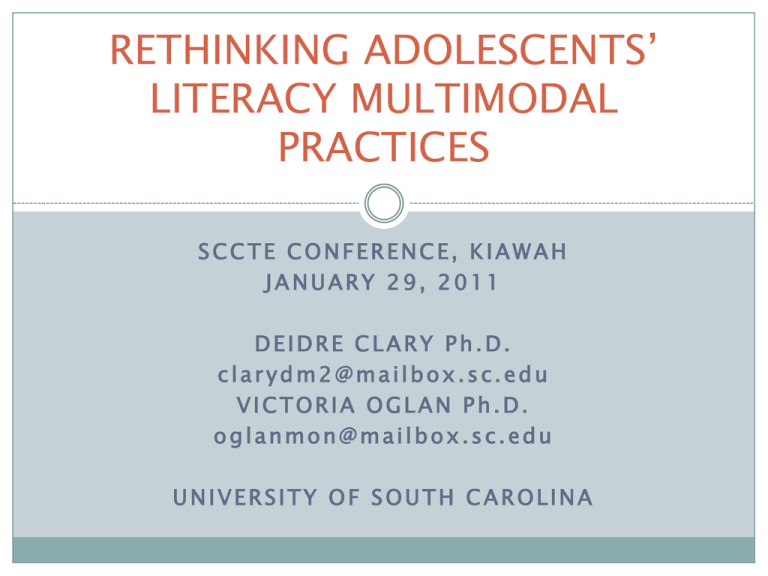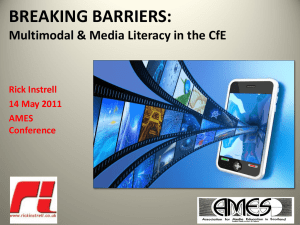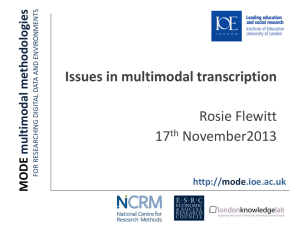literacy multimodal practices - University of South Carolina
advertisement

RETHINKING ADOLESCENTS’ LITERACY MULTIMODAL PRACTICES SCCTE CONFERENCE, KIAWAH JANUARY 29, 2011 DEIDRE CLARY Ph.D. clarydm2@mailbox.sc.edu VICTORIA OGLAN Ph.D. oglanmon@mailbox.sc.edu UNIVERSITY OF SOUTH CAROLINA Checking Facebook Texting friends Multitasking Pen and paper format School curriculum is text based Individual presentations are common The written word is not enough “This is an age of multimedia authoring where competency with the written word is still vital, but no longer all that is needed” (Mills, 2010, p. 36). Some significant stats Number of households with internet capability rose from 47% (1999) to 74% (2004) 8-18 year olds spent an average of 6.5 hours/day involved in media (Roberts, Foehr & Rideout, 2005) Availability of technology in K-12 schools is on the rise; 99% schools are connected to the internet (Coiro, Knobel, Lankshear & Leu, 2008). 87% of 12-17 year olds use the internet; 68% use it at school (Rainie & Hitlin, 2005). How well do you know your students? 1. Do your students have internet access at home? How do you make accommodation for students who do not have internet access? 2. What do you know about their internet use? What do you know about their internet navigation skills? 3. Do your students find the quantity of information on the internet overwhelming? How do you assist them develop effective information seeking skills? 4. What informal adolescent literacies do your students use? Do your encourage your students to use these in your classroom? If so, what, New challenge for learning in our schools Current research emphasizes how students INTUITIVELY acquire new “deep and rich” literacies in out of school spaces . Students’ out of school literacies promote processes of learning that are “deeper and richer than the forms of learning to which they (students) are exposed in schools” (Gee, 2004, p. 107). Digital Youth Project describes rich learning outside school mostly in settings of peerbased interaction (Mizuko et al., 2008). Bridging the divide Students draw from their informal experience with multimodal texts to connect with mature literacy practices in school contexts, creating distinct borders between home & school (Dyson, 2003). Street (2003) argues that we need to bridge the divide separating literacy learning from the lived experience of students in their communities. Opposing mindsets about literacy INSTITUTIONAL Literacy exists in traditional paper and pencil form - scarcity and production of goods is valued. STUDENT Literacy thrives in contemporary activities involving multimedia – participation and distribution of goods & information is valued. Shifting our definition of literacy Schools can take advantage of digital technologies that adolescents use. Instead of limiting focus on teaching students to read using textbooks and write using paper and word-processing programs, schools might expand their notion of literacy instruction and treat it as read & writing for the purposes of communicating in many traditional & contemporary modes using multiples tools & resources (Tarasuik, 2010). What do you know about your students’ digital literacies? 1. Do your students read digital texts for meaning in the same way as they read traditional texts? 2. What digital reading strategies need to be developed for deeper levels of inferential, analytical, critical and evaluative understandings? 2. What differences are there between the process of sending a text message and handwriting a message on paper? 3. How do we incorporate the possibilities of imaginative design and production possible for a website, blog or DVD into the English curriculum? Multimodality matters Multimodality is vital to the literacy practices of youth and adults in the globalized communities environment (Cope & Kalantzis, 2000). It is incumbent on teachers to include new literacies using digital media to make connections between learning spaces of home & school. Not all adolescents today are “digital natives” (Prensky, 2001). Greater emphasis must be placed on expert scaffolding of new literacies in school settings in order to extend students’ repertoire of skills and genres. What is multimodality? Multimodality: the combination of two or more modes in representation - linguistic (written words), visual, audio, gestural, and spatial (New London Group, 1996). Example. Social networking eg designing a Facebook profile. What others can you think of? Multiple platforms in culturally diverse social settings Japanese style comics, or manga- “amusing drawings” (Schwartz & Rubenstein-Avila, 2006). Digital movie composing (Brass, 2008; Ranker, 2008) Graffiti (Vasudevan , 2006) Online fanfiction (Black, 2005) Cell phone advertising (Ajayi, 2009) Illustrated stories (Debruin-Parecki & Klein, 2003) Rap lyrics (McGinnis, 2007) Vooks (Groenke, Bell, Allen & Maples, 2011) Examining assumptions about adolescent literacies Not all adolescents are “digital natives.” (Differences in multimodal & digital practices exist across social groups. Teachers have a role in guiding students to participate in new practices for social, recreational & civic engagement). 2. Adolescents’ engagement in multimodal textual practices is not only about “fitting” English to the interests of students. (Textual practices can be created and encouraged). 3. Students multimodal practices are essentially recreational. (These practices need to be “balanced” with scaffolded multimodal practices in school settings). 1. How much should social, workplace, and recreational literacies influence the curriculum? Dewey (1929). Emphasized learners’ readiness to learn and need to account for the knowledge, skills & interests of learner as motivation for instruction. This view supports thinking for not teaching practices of formal or recognized literacies because they are situated beyond the student’s direct experience. Is this your view? Vygotsky (1978). Argued that adults should not deny students abstract learning experiences on the basis of their supposed level of development but rather assist students to achieve their potential within the ZPD. This view suggests that ELA teachers need not surrender school sanctioned literacies to the informal literacies of adolescents. The converse also applies. What is your view? Guiding students to new multimodal literacy practices “Just as we should not lose sight of the adaptability of some unschooled abilities, we must also guard against expecting more of them than they can deliver”(Damon, 1990) “… generative multimodal practices among youth are often limited by uneven access to technologies, critical literacies, and specialist knowledge of media & technology” (Mills, 2010, p. 40). Rethinking multimodal design ELA teachers approach multimodal designing with significant background knowledge of the linguistic mode (written word) eg genre or text structure, vocabulary choice, sentence construction. These linguistic design elements have different degrees of stability or change in new multimodal texts eg film making. Multimodal literacy using film In film making, commonality exists between the text structure of written & visual narratives. Movie scripts and written narrative share development of a setting, characters, plot, etc Teachers can model & collaboratively construct movie scripts & written narratives that address textual codes & conventions of this genre. When creating multimodal texts, students focus on visual ,spatial, gestural or audio modes eg storyboards, music, sound effects, narration. They also need to attend to technical skills eg movie making software to capture frames & digitally edit the movie. Multimodal literacy within the podcasting process Podcasting has become a popular development within web 2 technology and enables a range of modes to be used in the production of a multimedia experience. Students may be engaged in a range of literacy tasks of researching, planning and writing texts for broadcasting while learning about the technology of using audio and video files to produce their podcasts. In pairs, the students can plan, develop, draft, produce and refine an 8-minute podcast suitable for sharing with a broad audience. The final podcasts can be uploaded onto I-tunes as well as onto the school’s website. Observations A classroom writing task needs no longer to be seen as confined to writing a particular genre or text-type to be edited and produced on paper. The podcasting process itself introduces a new genre that incorporates other genres. Podcasting is an example of multimodal literacy that involves students working together: talking, listening, planning, reading, researching, designing, writing and producing using both print and digital modes. Multimodal literacy using Wikis A wiki consists of a set of webpages where collaborations contribute and modify information about specific subjects. Authors edit and add information simultaneously. They can post images, add links to other sites relevant to their topic. Wikis can be established on PBworks (pbworks.com). Example: Students collaborate on a novel. On their web pages, they can organize their information about vocabulary, summaries, characterization as they read the novel. They can also explore other tools eg add chat boxes. Observations “Students put in more effort . Since Wikis can be viewed on the internet, they tend to be more thoughtful & deliberate. “ “I found students had created something new and extended their learning themselves.” Digital Book Talks or Trailers Similar to the traditional book talk, they give the reader enough information to lure him/her into reading the novel. They can be shared on the school website. As for film making, students work with visuals, music, sound effects, storyboards to scaffold their “talks.” One teacher used a scene planner to help students organize their talk. Digital book talks promote the use of reading strategies such as questioning, rereading, clarifying. So what! Adolescents are continually discovering certain multimodal literacy practices through informal networks. Schools have a role to introduce new literacies. Creating space for students to make connections with popular & multimodal texts in the ELA classroom is necessary, but insufficient, to prepare students for social & civic engagement. Students need guidance by experts to move them beyond the known to the new. They are not experts of many important multimodal and digital practices (DeBell & Chapman, 2003) Rethinking our practice The teacher’s role is to “facilitate students’ experiences with digital literacy tools in school. What we are less certain about, and less knowledgeable about, is the particular focus that facilitative support should take” (Moran, Ferdig, Pearson, Wardrop & Blomeyer, 2008, p. 13). Teachers can use “distributed expertise” to make multimodal literacy practices collaborative (Brown et al., 1993). Collaboration between experts & novices contributes to the construction of multimodal texts that are more complex than those constructed independently. Working in digital media means that students’ projects evolve and create new texts. Teachers cannot expect students to replicate text. Teachers can incorporate students’ predilections while extending the range of multimodal literacy practices that are already familiar to them (Hull & Schlutz, 2001). “Recognition of informal adolescent literacies needs to be tempered with knowledge of the multimodal textual encounters that youth still need to traverse” (Mills, 2010, p. 39). Helping “digital immigrants” use web 2.00 Find one tool that you think has use in your classroom and use it. Start small. Start with a tool that complements what you are currently doing as a teacher, or with your students. Start with something you are comfortable with. Read What Video Games Have to Teach Us about Literacy and Learning (Gee, 2007). Here are some great blog sites and others. Get connected www.classroom20.com www.freetech4teachers.com www.teach42.com www.speedofcreativity.org www.wikispaces.com www.techlearning.com/article/7636 www.ehow.com/how_4828602_own-digital-movie.html ignite.wikis.birmingham.k12.mi.us/Digital+Book+Talk colquitt.k12.ga.us/cchsmedia/cchsdigitalbooktalks.htm www.edmodo.com www.ning.com www.polarhusky.com A work in progress…closing thoughts Adolescent literacy, despite its current increase in attention in research literature, is still a work in progress. As teachers of adolescents, so are we. Combining what our observations tell us, along with offering students freedom to incorporate their own knowledge, will help us best in planning the most effective practices and instruction for our students.” (A middle school teacher, 2010) Teachers: A work in progress








